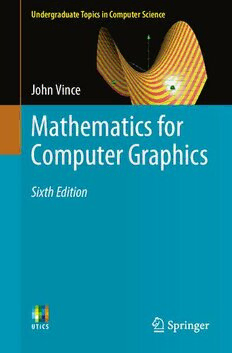Table Of ContentUndergraduate Topics in Computer Science
John Vince
Mathematics for
Computer Graphics
Sixth Edition
Undergraduate Topics in Computer
Science
SeriesEditor
IanMackie,UniversityofSussex,Brighton,UK
AdvisoryEditors
SamsonAbramsky ,DepartmentofComputerScience,UniversityofOxford,
Oxford,UK
ChrisHankin ,DepartmentofComputing,ImperialCollegeLondon,London,UK
MikeHinchey ,Lero–TheIrishSoftwareResearchCentre,Universityof
Limerick,Limerick,Ireland
DexterC.Kozen,DepartmentofComputerScience,CornellUniversity,Ithaca,
NY,USA
AndrewPitts ,DepartmentofComputerScienceandTechnology,Universityof
Cambridge,Cambridge,UK
HanneRiisNielson ,DepartmentofAppliedMathematicsandComputerScience,
TechnicalUniversityofDenmark,KongensLyngby,Denmark
StevenS.Skiena,DepartmentofComputerScience,StonyBrookUniversity,Stony
Brook,NY,USA
IainStewart ,DepartmentofComputerScience,DurhamUniversity,Durham,
UK
‘Undergraduate Topics in Computer Science’ (UTiCS) delivers high-quality
instructional content for undergraduates studying in all areas of computing and
information science. From core foundational and theoretical material to final-year
topics and applications, UTiCS books take a fresh, concise, and modern approach
and are ideal for self-study or for a one- or two-semester course. The texts are all
authoredbyestablishedexpertsintheirfields,reviewedbyaninternationaladvisory
board,andcontainnumerousexamplesandproblems,manyofwhichincludefully
workedsolutions.
TheUTiCSconceptreliesonhigh-quality,concisebooksinsoftbackformat,and
generally a maximum of 275–300 pages. For undergraduate textbooks that are
likelytobelonger,moreexpository,Springercontinuestoofferthehighlyregarded
TextsinComputerScienceseries,towhichwereferpotentialauthors.
Moreinformationaboutthisseriesathttps://link.springer.com/bookseries/7592
John Vince
Mathematics for Computer
Graphics
Sixth Edition
JohnVince
Breinton,UK
ISSN1863-7310 ISSN2197-1781 (electronic)
UndergraduateTopicsinComputerScience
ISBN978-1-4471-7519-3 ISBN978-1-4471-7520-9 (eBook)
https://doi.org/10.1007/978-1-4471-7520-9
1st–5theditions:©Springer-VerlagLondonLtd.2001,2006,2010,2014,2017
6thedition:©Springer-VerlagLondonLtd.,partofSpringerNature2022
Theauthor(s)has/haveassertedtheirright(s)tobeidentifiedastheauthor(s)ofthisworkinaccordance
withtheCopyright,DesignsandPatentsAct1988.
Thisworkissubjecttocopyright.AllrightsarereservedbythePublisher,whetherthewholeorpartof
thematerialisconcerned,specificallytherightsoftranslation,reprinting,reuseofillustrations,recitation,
broadcasting,reproductiononmicrofilmsorinanyotherphysicalway,andtransmissionorinformation
storageandretrieval,electronicadaptation,computersoftware,orbysimilarordissimilarmethodology
nowknownorhereafterdeveloped.
Theuseofgeneraldescriptivenames,registerednames,trademarks,servicemarks,etc.inthispublication
doesnotimply,evenintheabsenceofaspecificstatement,thatsuchnamesareexemptfromtherelevant
protectivelawsandregulationsandthereforefreeforgeneraluse.
Thepublisher,theauthorsandtheeditorsaresafetoassumethattheadviceandinformationinthisbook
arebelievedtobetrueandaccurateatthedateofpublication.Neitherthepublishernortheauthorsor
theeditorsgiveawarranty,expressedorimplied,withrespecttothematerialcontainedhereinorforany
errorsoromissionsthatmayhavebeenmade.Thepublisherremainsneutralwithregardtojurisdictional
claimsinpublishedmapsandinstitutionalaffiliations.
ThisSpringerimprintispublishedbytheregisteredcompanySpringer-VerlagLondonLtd.partofSpringer
Nature.
Theregisteredcompanyaddressis:TheCampus,4CrinanStreet,London,N19XW,UnitedKingdom
Thisbookisdedicatedtomywife,Heidi.
Preface
The first edition of this book began life as part of Springer’s Essential series and
containedtenchaptersandapproximately220pages.Thissixthandlasteditionhas
twentychaptersandapproximately600pages.Overtheinterveningeditions,Ihave
revisedandextendedpreviousdescriptionsandintroducednewchaptersonsubjects
that I believe are relevant to computer graphics, such as differential calculus and
interpolation, and new subjects that I had to learn about, such as quaternions and
geometric algebra. Hopefully, this edition explores enough mathematical ideas to
satisfymostpeopleworkingincomputergraphics.
AlthoughthefirsteditionofthisbookwasproducedonahumblePCusingWORD,
subsequenteditionswereproducedonanAppleiMacusingLATEX.Irecommendto
anybuddingauthorsthattheyshouldlearnLATEXanduseSpringer’stemplatesto
createtheirfirstmanuscript.Furthermore,today’scomputersaresofastthatIoften
compiletheentirebookforthesakeofchangingasinglecharacter—itonlytakes5
or6seconds!
Ihaveusedcolourinthetexttoemphasisethepatternsbehindcertainnumbers
andintheillustrationstoclarifythemathematics.
It is extremely difficult to ensure that there are no spelling mistakes, missing
brackets, spurious punctuation marks and, above all, mathematical errors. I truly
havedonemybesttocorrectthetextandassociatedequations,butifIhavemissed
some,thenIapologisenow.
In all of my books, I try to mention the names of important mathematicians
associatedwithaninventionordiscoveryandtheperiodoverwhichtheywerealive.
Inthisbook,Imention50suchpeople,andtherelevantdatesareattachedtothefirst
citation.
Whilst writing this book I have borne in mind what it was like for me when I
wasstudyingdifferentareasofmathematicsforthefirsttime.Inspiteofreadingand
rereadinganexplanationseveraltimes,itcouldtakedaysbefore‘thepennydropped’
andaconceptbecameapparent.Hopefully,thereaderwillfindthefollowingexplana-
tionsusefulindevelopingtheirunderstandingofthesespecificareasofmathematics
andenjoythesoundofvariouspenniesdropping!
vii
viii Preface
IwouldliketothankHelenDesmond,EditorforComputerScience,forallowing
metogiveupholidaysandhobbiesinordertocompleteanotherbook!
Breinton,UK JohnVince
May2022
Contents
1 Introduction .................................................. 1
1.1 MathematicsforComputerGraphics ....................... 1
1.2 UnderstandingMathematics .............................. 1
1.3 WhatMakesMathematicsDifficult? ....................... 2
1.4 BackgroundtoThisBook ................................ 2
1.5 HowtoUseThisBook ................................... 2
1.6 SymbolsandNotation ................................... 3
References .................................................... 4
2 Numbers ..................................................... 5
2.1 Introduction ............................................ 5
2.2 Background ............................................ 5
2.3 Counting ............................................... 5
2.4 SetsofNumbers ........................................ 6
2.5 Zero ................................................... 7
2.6 NegativeNumbers ....................................... 8
2.6.1 The Arithmetic of Positive and Negative
Numbers ..................................... 9
2.7 ObservationsandAxioms ................................ 10
2.7.1 CommutativeLaw ............................. 10
2.7.2 AssociativeLaw ............................... 10
2.7.3 DistributiveLaw .............................. 11
2.8 TheBaseofaNumberSystem ............................ 11
2.8.1 Background .................................. 11
2.8.2 OctalNumbers ................................ 12
2.8.3 BinaryNumbers ............................... 13
2.8.4 HexadecimalNumbers ......................... 13
2.8.5 AddingBinaryNumbers ........................ 16
2.8.6 SubtractingBinaryNumbers .................... 18
ix
x Contents
2.9 TypesofNumbers ....................................... 18
2.9.1 NaturalNumbers .............................. 19
2.9.2 Integers ...................................... 19
2.9.3 RationalNumbers ............................. 19
2.9.4 IrrationalNumbers ............................. 20
2.9.5 RealNumbers ................................. 20
2.9.6 AlgebraicandTranscendentalNumbers ........... 20
2.9.7 ImaginaryNumbers ............................ 21
2.9.8 ComplexNumbers ............................. 24
2.9.9 TranscendentalandAlgebraicNumbers ........... 26
2.9.10 Infinity ....................................... 27
2.10 Summary .............................................. 28
2.11 WorkedExamples ....................................... 28
2.11.1 AlgebraicExpansion ........................... 28
2.11.2 BinarySubtraction ............................. 28
2.11.3 ComplexNumbers ............................. 28
2.11.4 ComplexRotation ............................. 29
3 Algebra ...................................................... 31
3.1 Introduction ............................................ 31
3.2 Background ............................................ 32
3.2.1 SolvingtheRootsofaQuadraticEquation ........ 33
3.3 Indices ................................................ 37
3.3.1 LawsofIndices ............................... 38
3.4 Logarithms ............................................. 38
3.5 FurtherNotation ........................................ 40
3.6 Functions .............................................. 40
3.6.1 ExplicitandImplicitEquations .................. 41
3.6.2 FunctionNotation ............................. 41
3.6.3 Intervals ...................................... 42
3.6.4 FunctionDomainsandRanges .................. 43
3.6.5 OddandEvenFunctions ........................ 44
3.6.6 PowerFunctions .............................. 46
3.7 Summary .............................................. 46
3.8 WorkedExamples ....................................... 46
3.8.1 AlgebraicManipulation ........................ 46
3.8.2 SolvingaQuadraticEquation ................... 47
3.8.3 Factorising ................................... 49
References .................................................... 49
4 Trigonometry ................................................. 51
4.1 Introduction ............................................ 51
4.2 Background ............................................ 51
4.3 UnitsofAngularMeasurement ............................ 51

